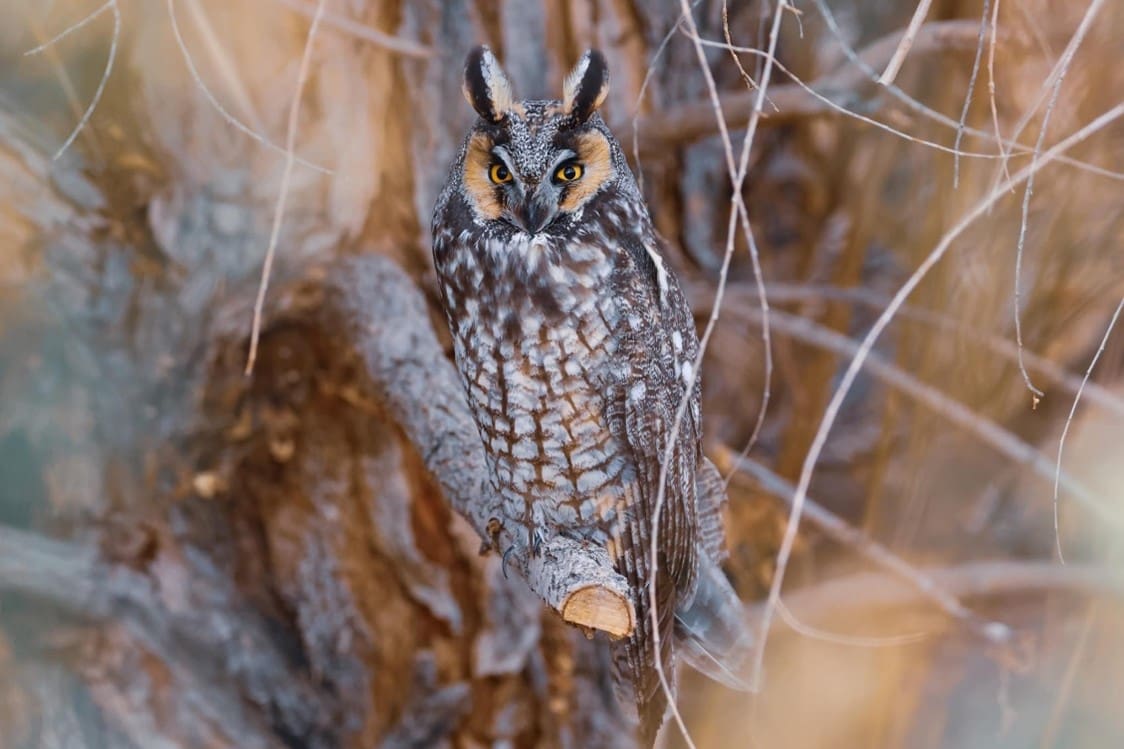The Long-eared Owl

“Whoo” Has Ear Tufts that Are Long, Loonger, Looongest?
What a treat for Clark County Wetlands Park explorers! The long-eared owl (Asio otus) is a rare resident at the Park and the last few weeks have been great for sightings in the Nature Preserve’s Cottonwood Grove where this photo was taken.
While long-eared owls have a range that includes much of the northern hemisphere, they are never common. Nevada is typical; these owls breed in numerous areas in the state, but not in high concentrations in any one spot as they tend to have very specific habitat needs. The long-ears tend to roost by day in dense vegetation—riparian or streamside habitats are ideal—which also provide most of the suitable habitat for their nesting needs in the western United States. But they hunt exclusively by night over open grasslands and shrub lands, and so require two distinct habitats adjacent to each other. The Park, with both riparian and open desert scrub habitat within its boundaries, and desert scrub nearby, suits the long-eared owls to a “T”.
Long-eared owls “on the hunt” appear to fly with great buoyancy on long wings with light wing loading, scanning the ground for their favorite food—small mammals. Researchers dissected more than 30,000 owl pellets (regurgitate they expel after their meals) and determined that mice and voles of various species are especially enjoyed. Occasional reptiles and amphibians round out the owl buffet.
Like most owls, Long-ears can be difficult for us to see. Their coloration helps them blend against their treetop roosts, and they are usually quiet during daylight hours when humans are out and around. One of the best times to spot them is at dusk, just as they become active for a night’s hunting. If you happen to discover a nesting area in early spring, you may hear the owls before you see them. Long-eared owls in their breeding grounds may hoot, whistle, hiss, or even make what has been described as “wild wailing sounds.” Though like all owls they are silent flyers, the courting long-ears may make a distinctive “clapping” sound by striking their wings or carpal bones together below the body as they fly!
Long-eared owls are often confused with the great horned owls (Bubo virginianus) that are more common Park residents, probably because both have ear tufts on top of their heads. Looking at body size, ear tufts, and facial discs can help sort them out. Great horned owls are larger (22 inches long) and appear bulky. Their ear tufts are shorter and spaced wide apart on the head, making the head look cat-like. They have a round facial disc and large eyes that give them a calm appearance. Long-eared owls are smaller (15 inches long) and more slender. Their ear tufts are longer, thinner. and more closely set on the head. They have a more vertical tawny-orange facial disc bordered by dark vertical stripes and smaller eyes, giving them a surprised look.
Take advantage of our early spring weather at the Park! If possible, take a walk soon and watch the trees overhead for long-eared owls. Don’t be surprised if the owl stretches its body and its ear tufts to maximum length and makes itself very tall and slender when you approach. This elongated shape is a form of camouflage that’s intended to hide the owl from you by making it look like the ragged stump of a broken tree branch!
By Chris Leavitt, President; photo by Phil Martini
Please enjoy these YouTube videos!
Long-eared Owl, Asio otus
Long-eared owl roosting Trinity River Dallas, Texas
Long-eared Owls
